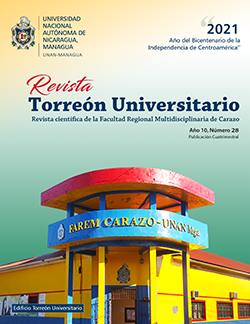Structure of the diatom communities of the sediments of Lake Cocibolca and its relationship with the natural and anthropogenic events
Keywords:
Cocibolca Lake, diatoms, index, diversity, sedimentAbstract
In order to identify diatoms and thier behavior in a sediment profile and thier relation topl natural and anthropogenic events, sediment sampling was carried out in Cocibolca Lake. A total of 46 taxa were identified with the highest diversity at the PLN I site (41 taxa) and the least at the PLN II site (24 taxa). The most representative genus in the PLN I were: Aulacoseira (12.20%), Fragilaria (7%), Navicula (12.20%), Nitzschia (7.32%), Pseudostaurosira (12.20%), and Surirella (9.76%). At the PLN II site they were: Aulacoseira (20.83%), Nitzschia (12.50%), Pseudostaurosira (12.50%), Surirella (8.33%), Cyclotella (8.33%) and Synedra (8 , 33%).
Within the genus Aulacoseira the species A. muzzanensis showed to be the most dominant (44%; PLN I) and (64.58% PLN II). Of the species found, four of them (Aulacoseira ambigua, A. subartica, Discotella stelligera and Stephanodiscus) show significant oscillations such as the replacement of one species by another that depends on environmental changes in the aquatic environment. The PLN I site shows more evidence of the changes that the body of water had at some time, which is reflected in the dominance of one species when another disappears. Presumably, for a time the conditions of the lake varied, being better observed at this site.
The application of the Shannon and Simpson indices show that the PLN I site is where the highest calculated values are observed (1,081 and 2,412 bit) respectively
Downloads
References
Barber, H. G. & E. Y. Haworth, (1981). A guide to the morphology of the Diatom Frustule. Freshwater Biological Association. Scientific Publication No. 44, p. 105 - 109.
Bouza, N. Covarrubias, D. ( 2005). Estimación del índice de diversidad de Simpson en m sitios de muestreo. Revista Investigación Operacional.
Caballero, M.; Valadez, F. Y Rodriguez, (2014). Paleolimnología: Como descifrar la historia de los lagos y su entorno a partir del studio de sus sedimemtos.
Denys y de Wolf (1999). Diatoms as indicators of coastal paleoenvironments and relative sea-level change. In Stoermer, E.F. & J. P. Smol (eds.) The Diatoms: Applications for the Environmental and Earth sciences. Cambridge University Press New York: 277-297.
Escobar, J.; Restrepo, J.C. Y Martínez, J. I. (2005) “La paleolimnología como herramienta para el estudio y manejo de embalses”. Universidad Nacional de Colombia - Red de Revistas Científicas de América Latina, el Caribe, España y Portugal Sistema de Información Científica. vol. 8 Núm. 2 pp. 51-59.
García Rodríguez, F. et al. (2011). Diatoms, protein and carbohudrate sediment content as proxies for coastal eutrophication in Montevideo, Río de la Plata estuary, Uruguay. Braz j. Oceanogr 59(4): 293-310.
De Wolf, H. (1982). Methods of coding of ecological data from diatoms for cometer utilization. Med Rijks Geol Dienst 36:95-99.
Licursi et al. (2006): Diatoms assemblages from a turbid coastal plain stuary: Rio de la Plata( South of America). J Marsyst 62:33-45.
Mann, D. G. (2010). Diatoms
Margalef, (1983). Limnologia. Omega, 1001 pp.
Pla, L. (2006). Biodiversidad: inferencia basada en el índice de Shannon y la riqueza. Interciencia. Vol. 31 N. 8 ISSN 0378-1844.
Prygiel, J. and Coste, M. (2000). Guide méthologique pour I´Indice Biologique Diatomées. NFT 90-354. Étude Agence Bordeaux, March 2000, Agences de I´Eau France.
Sharov, A. (2008). Phytoplankton as an indicator in estimating long-term changes in the water quality of large lakes. Water Resour. 35 (6) 668–673.
Siqueiros-Beltrone, D. A. (2002). Diatomeas bentónicas de la Peninsula de baja California; diversidad y potencial ecológico CICIMA. Libros de Ciencias Marinas. IPN-UABCS
Smol, J. P. (2008). Pollution of Lakes and Rivers: A Paleoenvironmental Perspective, 2nd Edition. Blackwell Publ.383 pp.
Stevenson, R. J. & Pan, Y. (1999). Assessing environmental conditions in rivers and strems with diatoms. In the Diatoms: Applications for the Environmental and Earth sciences. Cambridge University Press, Cambridge University Press, pp.11-40.
Van Dam et al. (1994). A coded cheklist and ecological indicators values of freshwater diatoms from the Netherlands, Netherlands Journal of Aquatic Ecology, 28, 117-133
Vammen, Katherine; Pitty Tercero, Jorge y Montenegro Guillén, Salvador (2006). Evaluación del Proceso de Eutroficación del Lago Cocibolca,Nicaragua y sus causas en la Cuenca. In: Eutrofización en Sudamérica: Causas, Consecuencias y Tecnologías para Manejo y Control. Tundisi, José Galizia. ed.; Tundisi, Takako Matsumura. ed.; Galli, Corina Sidagis. ed., Instituto Internacional de Ecologia de Sao Carlos, pp. 35-58. ISBN 85-87418-05-X
Downloads
Published
How to Cite
Issue
Section
License
Copyright (c) 2021 Universidad Nacional Autónoma de Nicaragua, Managua

This work is licensed under a Creative Commons Attribution-NonCommercial-NoDerivatives 4.0 International License.
The authors who publish in this journal agree to the following terms.
- The author or authors of the articles, essays or research grant the National Autonomous University of Nicaragua, Managua (UNAN-Managua) the editing rights (copyright) of the submitted work, therefore the University has the exclusive right to publish the article for the entire copyright period.
- These copyrights/authors authorize Torreón Universitario Magazine and the University to edit and disseminate/publish the article in said Magazine, including printed and electronic reproduction, storage, retrieval and any other type of publication, and sources of secondary information as services. of summaries and databases, they also empower it to protect the article against unauthorized use for dissemination by printed or electronic media (PDF, HTML, EPUB, XML or others).
License for use of content
The magazine uses the Creative Commons Attribution-NonCommercial-NoDerivs 4.0 International License.
Under this statement:

This journal is licensed under a Creative Commons Attribution-NonCommercial-NoDerivatives 4.0 International License. It can be copied, distributed and transmitted publicly as long as the author and source are cited (Revista Torreón Universitario), it should not be modified or used for any commercial purpose. The full license can be found at http://creativecommons.org/licenses/by-nc-nd/4.0/.



